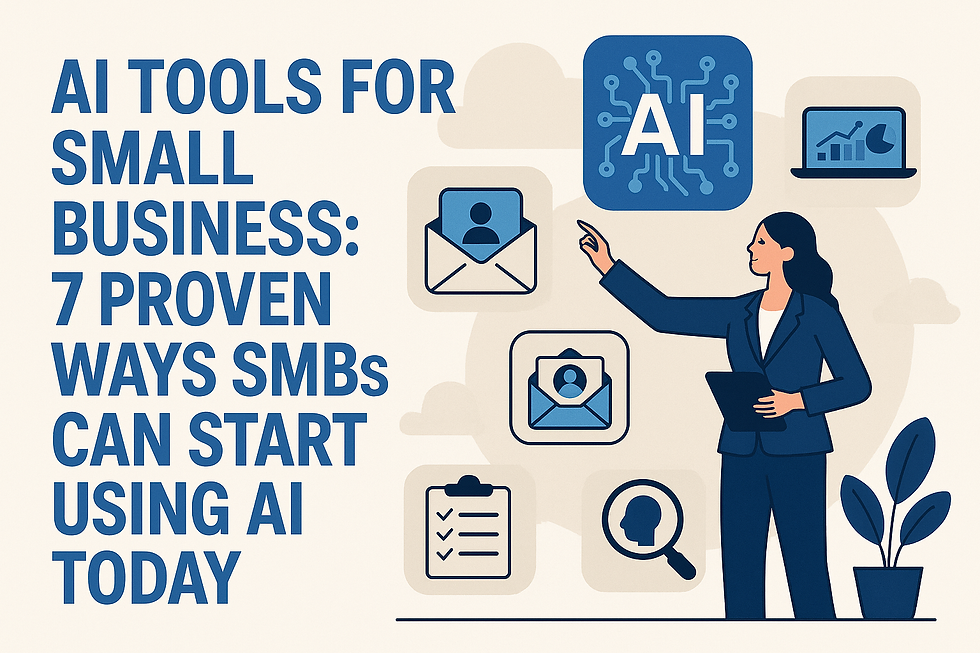AI Tools for Small Business: 7 Proven Ways SMBs Can Start Using AI Today
- Joe Tierney
- Aug 8
- 4 min read

Running a small business means wearing multiple hats while managing limited resources. Between handling customer service, managing finances, creating marketing content, and keeping your team productive, there never seems to be enough time in the day. What if AI could handle the repetitive tasks that eat up your valuable hours?
After helping SMBs optimize their technology for over 20 years, LeewardCloud.io has identified practical AI implementations that deliver immediate results without breaking the budget. Based on real success stories from companies already using AI, we'll show you exactly how to implement these same strategies in your business—scaled appropriately for SMB needs.
Why AI Makes Sense for Small Businesses Right Now
The AI tools available today aren't just for Fortune 500 companies anymore. Small businesses are finding that modern AI platforms offer affordable, easy-to-implement solutions that directly address their biggest challenges. You don't need a technical team or massive budget to get started.
Consider these real results from businesses using AI:
Customer support teams resolving 86% of inquiries automatically
Document review time cut by 50%
Code development accelerated by 60x
Meeting notes and action items generated automatically
Sales outreach personalized at scale
These aren't theoretical benefits—they're happening right now in businesses of all sizes. The key is knowing which tools to use and how to implement them effectively.
7 AI Quick Wins Your SMB Can Implement This Week
1. Automate Customer Support with AI Chatbots
Real-World Example: Small e-commerce businesses are automating up to 70% of customer inquiries using AI-powered chatbots. A small online retailer with 5 employees can now handle customer service volume that previously required 10 people.
Your First Step: Create a list of your 10 most common customer questions. Use AI to draft response templates, then implement them in a basic chatbot system.
2. Speed Up Content Creation
Real-World Example: Marketing agencies report creating content 10x faster while reducing costs. A small marketing team of 3 can now produce content volume that previously required 8 people.
Your First Step: Use AI to create a week's worth of social media posts for your business. Provide your brand voice guidelines and let AI generate variations you can refine.
3. Streamline Document Processing
Real-World Example: Small law firms using AI document review report cutting review time in half. A 10-person firm now handles the document volume of a 20-person firm.
Your First Step: Upload your standard contracts or invoices to an AI platform and ask it to identify key terms and create summaries. Build templates from these for faster processing.
4. Enhance Team Productivity
Real-World Example: Companies using AI meeting assistants save 5 hours per week on documentation. Teams report 30% better follow-through on action items because nothing gets missed.
Your First Step: Try an AI meeting assistant for your next team meeting. Review the automatic transcription and action items it generates.
5. Personalize Sales and Marketing
Real-World Example: Sales teams using AI for personalized outreach see response rates triple. A 2-person sales team can manage relationships like a 6-person team.
Your First Step: Use AI to analyze your best-performing sales emails and create personalized variations for different customer segments.
6. Accelerate Financial Tasks
Real-World Example: Small accounting firms using AI process invoices 20x faster. A single bookkeeper can now handle the workload of an entire accounting department.
Your First Step: Upload last month's expenses to an AI tool and ask it to categorize them. Use this as a template for ongoing automation.
7. Improve Hiring and Training
Real-World Example: Companies using AI for recruiting report cutting time-to-hire by 50% while improving candidate quality. Small HR teams operate like departments twice their size.
Your First Step: Use AI to create a skills-based job description and screening questions for your next open position.
Getting Started: Your AI Implementation Roadmap
Week 1: Foundation
Identify your biggest time drain (customer service, content, admin tasks)
Research AI tools that address that specific pain point
Start with free trials to test functionality
Week 2: Pilot Project
Choose one process to automate
Set up the AI tool with your data and requirements
Run parallel with your current process to compare results
Week 3: Refinement
Gather feedback from team members
Adjust AI settings and prompts based on results
Document what works and what doesn't
Week 4: Scale
Expand successful implementations
Add additional AI tools for other pain points
Calculate time and cost savings
Your Next Steps
The gap between SMBs using AI and those not using it grows wider every day. Companies that adopt AI now gain competitive advantages that compound over time. The question isn't whether to use AI, but which processes to automate first.
Start small, measure results, and expand what works. Within 30 days, you'll wonder how you ever managed without AI assistance. Your competitors are already making this transition—don't let them leave you behind.
Ready to implement AI in your business but not sure where to start?
Contact LeewardCloud.io for cost-free expert guidance tailored to your specific SMB needs. With 20+ years helping small businesses optimize technology, we'll create your personalized AI roadmap that delivers immediate ROI without overwhelming your team or budget.


Comments